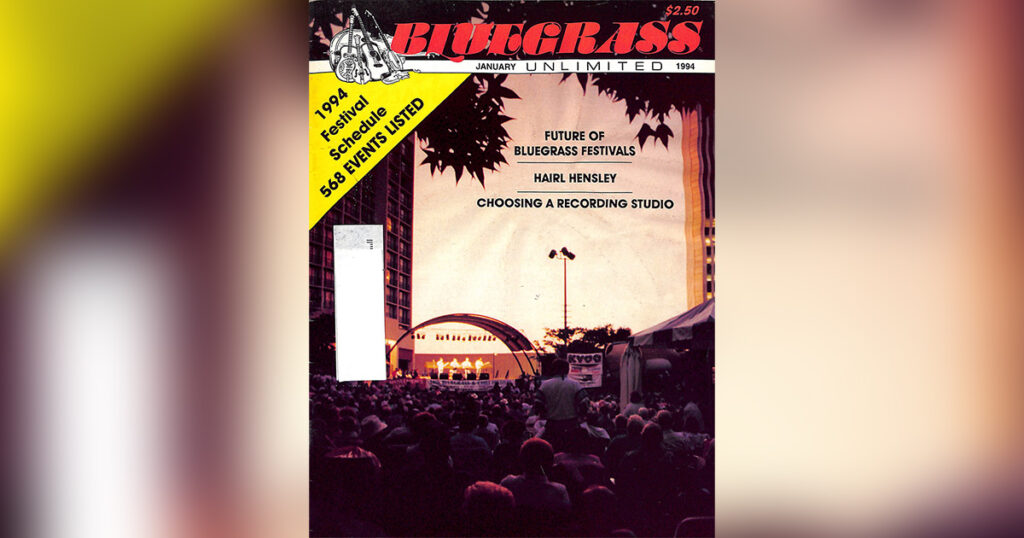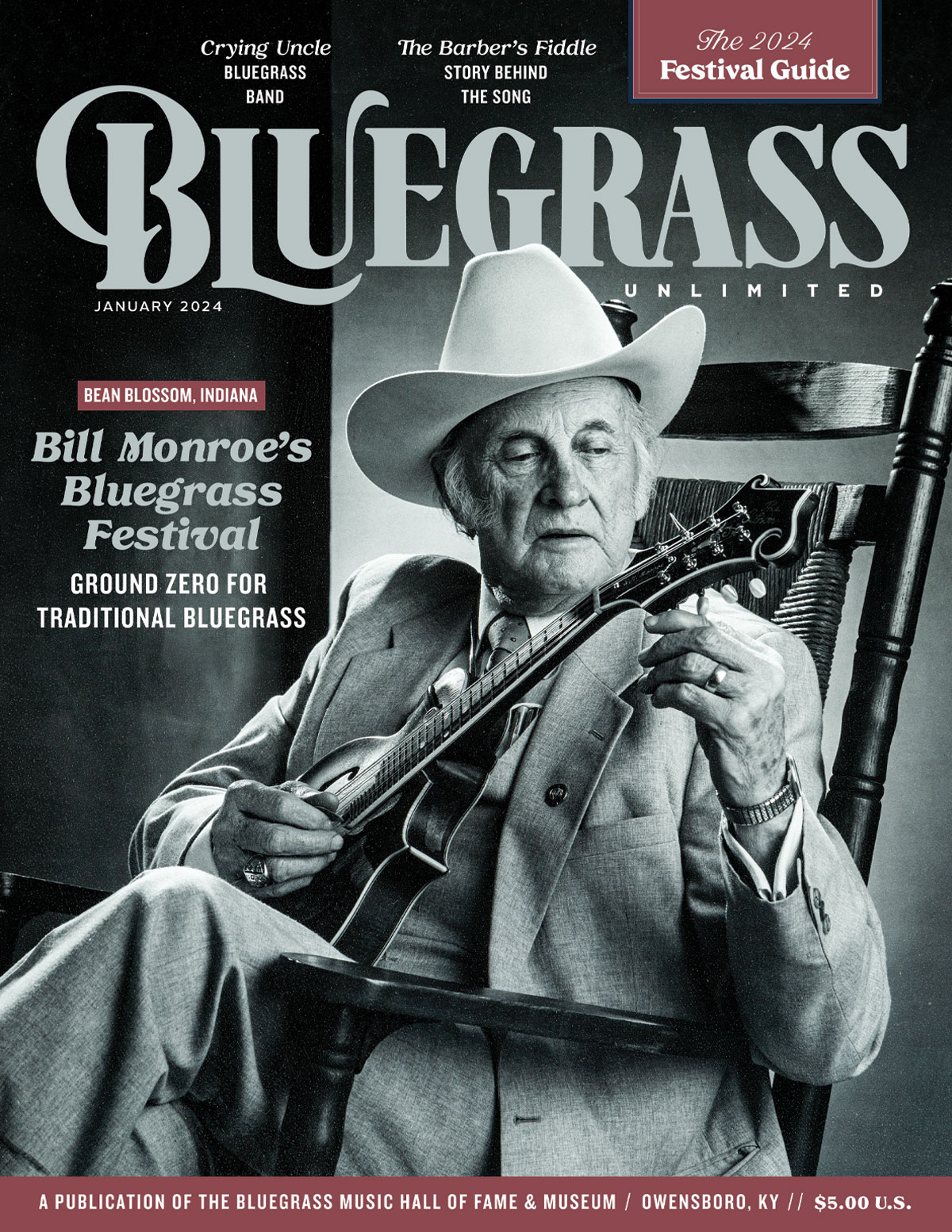Home > Articles > The Archives > The Future of Bluegrass Festivals—An Editorial Discussion According to Me and Sam
The Future of Bluegrass Festivals—An Editorial Discussion According to Me and Sam
Reprinted from Bluegrass Unlimited Magazine
January 1994, Volume 28, Number 7
What would you say if I told you that we both could go to one festival and on the same bill hear all these performers. Let’s see, there would be Alison Krauss, Michael Doucet, Beausoleil, the Seldom Scene, C.J. Chenier, California, the Basin Brothers, Dry Branch Fire Squad, Marc & Anne Savoy, Pete Wernick, Peter Rowan, the Poullard Brothers, Laurie Lewis, the Nashville Bluegrass Band, the Whitstein Brothers, Norman & Nancy Blake, D.L. Menard and a whole host of other bluegrass, Cajun, Zydeco superstars?”
“I’d say one of two things happened. Either you died and went to heaven or you won the lottery and produced that festival yourself.”
Around the smoldering fire late one Sunday night after the bluegrass festival crowds had gone home, Sam and I were reviewing the festival we’d just attended and the world in general, as if we had the power to change any of it. Sam said that as he watched the audiences at several recent bluegrass festivals, he realized how old-looking everyone appeared. I contributed, that I’d spoken about that very thing to Pete Roberts, who was older than dirt—having been around bluegrass almost since it was born—and he allowed as how the age of people who listened to bluegrass music and attended festivals might have reached its critical mass. In other words, Pete said, he was beginning to worry about the graying of the bluegrass audience.
“But what can we, the audience, do to attract younger people into our music?” Sam asked, but before I had a chance to reply he heatedly continued.
“Why it seems like only a few years ago, and I’m talkin’ about the ’80s, you could always find a half dozen teenaged kids waiting as Little Roy Lewis, Ricky Skaggs, Mark O’Connor, Raymond McLain or any of the Johnson Mountain Boys came off stage. Every one of those kids was just so full of the energy and enthusiasm that only a budding banjo picker, fiddler or flat-picker could generate, as they offered to carry their instruments back to their record table. And each hoped some of the hot-licks magic of their idols would rub off on him or her. Today, it’s only us ‘younger’ folks that have enough energy to get on up to their record table at all, much less figure out why them damn CDs cost so much more than the albums we used to buy.
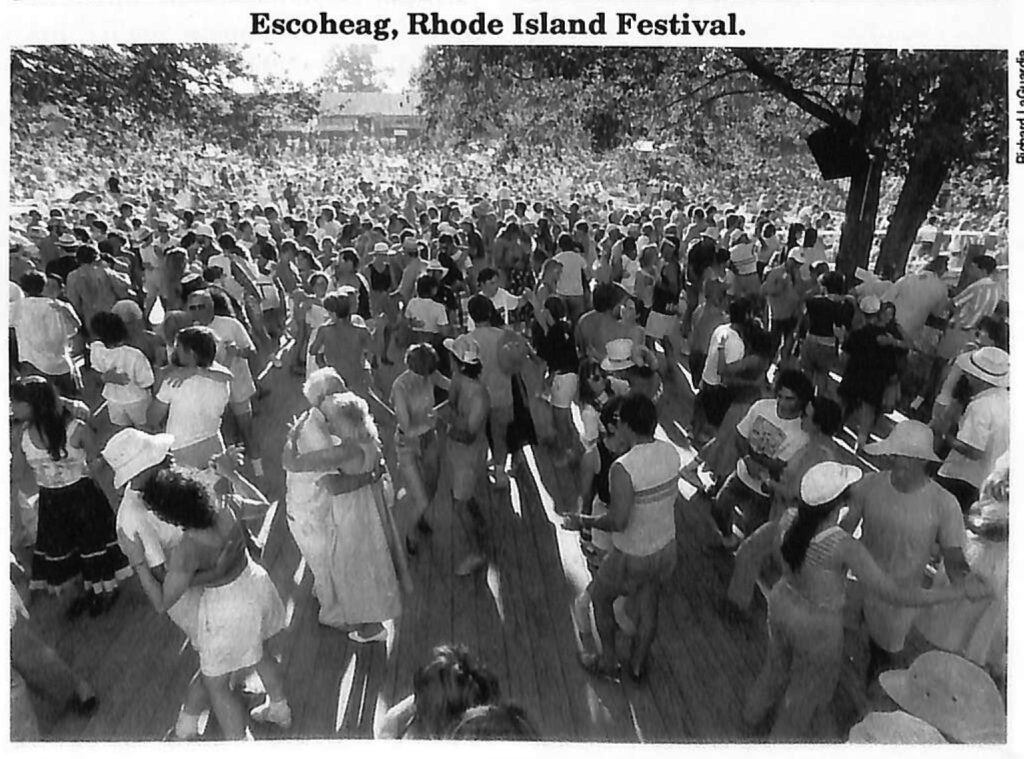
“Now hold on a minute, Sam,” I countered. “I went to a festival last Labor Day weekend that my family’s been attending for almost a decade, and never saw so many young people in my life. It’s that Bluegrass/Cajun Festival at Escoheag, R.I. They’ve been running for more than a dozen years and getting larger and younger crowds every year. I bet that this year there must have been close to 7,000 people there by Saturday afternoon; and the day crowd on Sunday pushed the paid attendance way past 12,000. “The 1993 3-day paid attendance by Sunday afternoon was 12,200,” says festival organizer, Chuck Wentworth, “and that’s up from 10,600 in ’92 and 10,300 in ’91.”
The ages you see run from newborn to retirees, but mostly we saw kids, young singles, marrieds and some oldsters. You know, what the media call the yuppies (young, urban, professionals), dinks (double income, no kids), and woofs (well off old folks).”
“These two festival producers, Chuck Wentworth and Franklin Zawacki, seem to have found at least one answer to the graying of the festival audience. What they do is mix bluegrass music with another “specialty” music (Cajun and Zydeco) and carefully balance the two to hold both audiences.”
“What the hell are you talking about,” Sam shot back. You can’t mix bluegrass music with any other music and not have bluegrass come out on the short end of the stick. Anybody who knows anything about our fans knows that each one of us has his own definition of what bluegrass music is and will die fighting to defend what he or she believes that is. And that simply translates into ‘anything I don’t like, ain’t bluegrass,’ and by playing any of that other stuff, you’re ruinin’ the purity of our beloved music.
“Now Sam, you don’t really believe that and I, for one, know that you like Cajun music.”
‘Yes sir and Zydeco too, but that’s not the issue here. I’m talkin’ about your typical bluegrass freak. That guy is so fanatic about his music. Maybe it’s his age or how long he’s been fightin’ to keep his music alive through every kind of attempted rip-off, but this fan is not going to allow any other music to get mixed up with his baby.
“Just check out any of your folk or jazz or any other ‘ethnic’ festivals today, and see how much bluegrass you hear there. Why in the early ’60s, the Philadelphia Folk Festival mixed Bill Monroe with lots of other music. A few years later the Newport Folk Festival hired other bluegrass super-stars and they performed on the same bill with the Father of Traditional Cajun Music, Dewy Balfa, plus a zillion other folkies and western swing pickers.
“But where’s the bluegrass at any of these kinds of festivals today? Look at any of your today’s Country Music shows out of Branson, Mo., or Nashville and see how much bluegrass you find there. Face it, man, there isn’t any more Beverly Hillbillies, nor Fire On The Mountain, except on reruns. Nah, your typical bluegrass festival fan won’t buy any mixing.”
‘Well, Sam, I’m here to tell you about festivals that do mix and have become very successful with that very formula. So sit back, stoke up the fire, and afterwards, maybe you’ll think a bit differently about mixing bluegrass with some other specialty music to reach a younger audience and hold its older fans too.”
“Many years ago, I spent a wonderful weekend in late September at the National Flatpicking Contests in Winfield, Kans. A guy named Bob Redford put on an almost week-long very exciting mix of bluegrass, folk, old-time and lots of other sub-specialties of non-mainstream and non-Nashville music. It was, at that time, one of the largest midwest festivals and I believe from reading their Walnut Valley Occasional, that it continues to grow each year.
“The year I attended there were so many campers that we spent more than two hours looking for our rig that had somehow gotten swallowed up in their Kansas-sized cornfield parking area. I got to ride in and shoot festival pictures from a cherry picker. The crowds were so spread out that even with my wide-angle lens from the top of the world, I could not capture the sheer sweep of all the people that were there. This was not a Woodstock, mind you, almost everything was acoustic, and I never heard any rock. But I did hear lots of different kinds of ‘our’ music including: Monroe, Crary, Blake, Doc Watson, Sam Bush, Pete Wernick, and many other up and coming hot-licks pickers. Some of these folks went on to go everywhere and some went absolutely nowhere. I wonder how much that Winfield Festival has changed today? Boy, those were great memories.”
“You sound like one of those Reunion stow-ries” Sam said. “Let’s not get nauseatingly nostalgic. We were talking about today, not the Bluegrass Ice Ages.
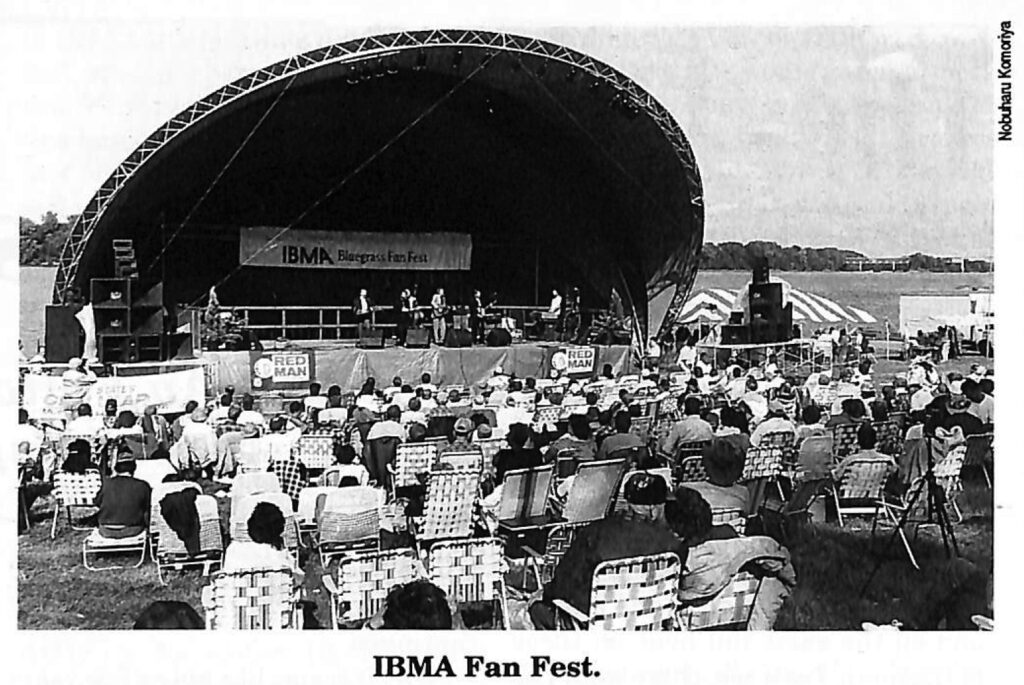
“Let me ask you something. Have you ever been out west to a bluegrass festival? When was the last time you’ve been to Telluride, Colo., or the Strawberry Festival in Yosemite, Cal.? I bet that’s where you’d hear some different bluegrass music and probably meet the kind of young people you were talkin’ about.” And what about the Merle Watson Festival way out in the western part of North Carolina, or the Winterhawk festival in upstate New York. These festivals seem to have been making the changes you’re talking about and showing the kinds of results, both in attendance and population profile, like that Escoheag, R.I., thing you described.
Sam went on to say: “I contacted B. Townes, who is the Festival Coordinator of the Merle Watson Festival and he told me enough about his festival to make me want to take a look at that one next year. Here’s what Townes said about their latest festival survey results. “Baby Boomers made up the largest portion of our audience. 66% were between the ages of 26 and 45, while only 30% were over 46. Our ’93 paid attendance was more than 16,800, which was up about 2,400 from ’92 and an incredible 8,800 more than our ’90 figures. More than a quarter of our attendees camped and almost half traveled more than 250 miles to get to the festival. Our music mix was country, folk, gospel, blues, old-time, as well as bluegrass but if you asked anyone at random they would probably say that they were at a bluegrass festival.’ ”
How Sam seems to know all this stuff is usually beyond me. But I do know that if Sam says it, he must have gotten it right. Like this little gem about the Winterhawk Festival. Sam said: “One of the Winterhawk promoters told me that they try to feature many of the new and younger musicians along side of the more established ones. That keeps both their music as well as their financial investment alive.”
“Well,” says I, “as long as I’ve been attending that Bluegrass/Cajun Festival at Mr. Davis’ Escoheag dude ranch their crowds appear to grow both in size as well as diversity. They are certainly getting younger and they seem to come from farther away.” “Roughly 20% of our patrons are campers while 80% travel in and out on a daily basis,” says Chuck Wentworth, “…generally they are from all up and down the East Coast of the U.S. and Canada with a few from California, Arizona, and New Mexico. Last year we had patrons from 28 different states and Canadian Provinces.”
It seems like Wentworth and Zawacki have hooked into a magic formula for festival success. They started out doing only one on Labor Day Weekend in Rhode Island but now they do four all over the country and are still talking more.
Lagniappe Productions (which is Chuck Wentworth) is contracted by Cajun Music Ltd. (which is Franklin Zawacki) to produce four festivals a year. Two are in California (the Bay Area & Long Beach) and two are at the Stepping Stone Ranch in Rhode Island. Besides the Labor Day thing, their Big Easy Bash, at the end of June, features Conjunto music (Tex- Mex, western swing, etc.) which is the music of the Mexican dance halls around San Antonio, Tex., mixed with Cajun and Zydeco.
“There’s talk now for them to produce their 1st Annual South/Southwest Festival in Arizona. This one features: “Cajun, Zydeco, Conjunto, Norteno, ‘chicken scratch’ (Waila/ Papago-Native American polkas), bluegrass, cowboy, mariachi, old timey and more.” Now how’s that Sam, for mixin’ up the music.”
“Yeah, well I don’t know,” Sam countered in a voice clearly suggesting he believed that maybe their elevator had failed to go all the way up.
“Well, I’ll tell you where I think their success comes from. Besides risking the music mix. Chuck and Franklin have reached their audience on at least three other important levels. That is, they actively deal with their gate payer’s children, their stomachs, as well as their feet.
“I asked Chuck, Tow relevant is your children’s program in bringing out the younger audience (i.e. young marrieds with kids)?’ His answer was very informative.”
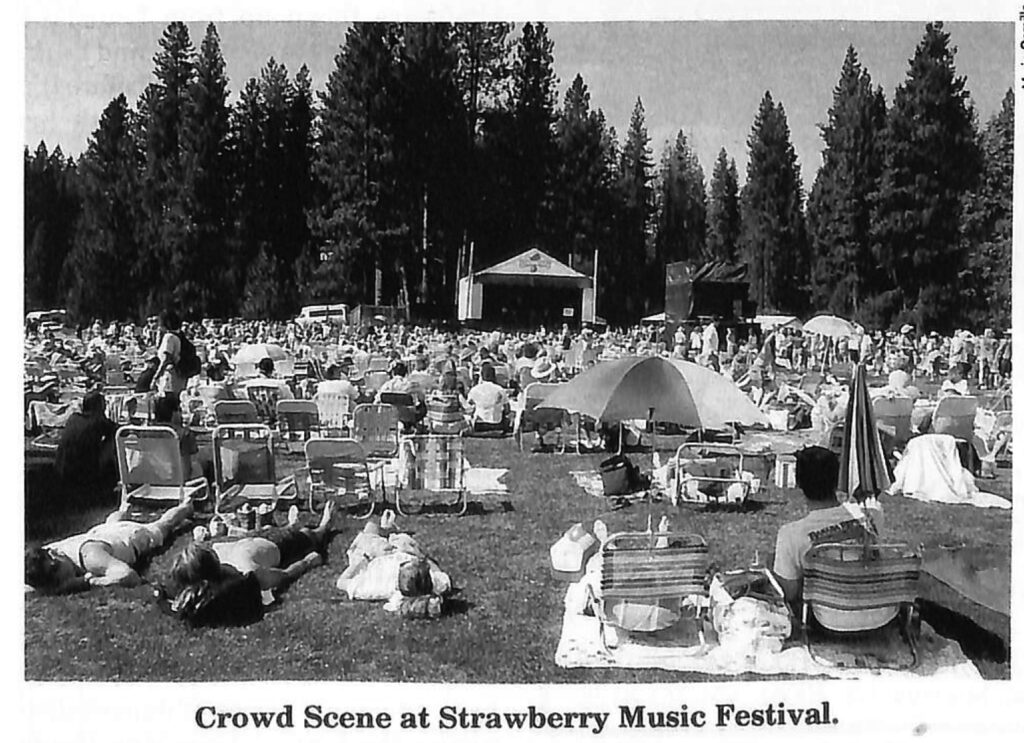
“Very relevant. Many young couples comment on how rare it is to go to a place and have separate entertainment for the kids as well as for themselves at the same time, and for no extra charge. After experimenting with the family entertainment concept for a few years, I decided, in 1990, to get serious and bring in national quality performers who specialize in children’s programming. Now, musicians, and storytellers entertain kids (and their parents and grandparents if they wish to stay) in a separate area that is specially designed and built for kids, and which is less than a minute’s walk from the main stage area. And for the kids, the highlight of the weekend is about 5 o’clock on both Saturday and Sunday afternoon, when they all dress up in costumes and make-up that they have created themselves and have a Mardi Gras parade throughout the entire stage area and audience, while one of the bands on stage plays some up-tempo march music and all the audience applauds. Franklin usually leads them in a sort of snake dance and we have so many kids, that it takes about a half hour.
Now, Sam, when was the last time you went to a festival and saw that many kids who were so well taken care of?” But before Sam had time to answer, I went on about their Cajun food.
“Chuck says: ‘Food is very important. The key to this festival is that it is an event, not just an ordinary music festival. That is why we bill it as a Music-Dance-Food Festival. In Louisiana, all the good times there are characterized by all three elements. You cannot have people get together for fun without music, food and drink, and dancing. They go together like the Holy Trinity, they are all part of a greater one. They’re inseparable, and we try to duplicate (or rather triplicate) that spirit at our event.
By now, almost everyone with a TV set knows how good Cajun cooking really is, and you can buy almost any kind of it at this festival. Their Cajun chefs are flown up from Louisiana especially for this festival, and begin their work four to five days before the music starts. Each starts with his own special roux and produces such real downhome fixin’s as: Boudin sausage, red beans and rice, crawfish etouffe, cornbread, chicken, sausage or seafood (loaded with hot shrimp) gumbo, Andouille hot dogs, Beignets and black bottom pie. The last few years their food has gotten even better, with some chefs from the Providence—Boston area adding some culinary elegance, but balanced, of course, by some real alligator stew straight from the bayou.’ ”
During the winter months for several years now, Chuck has courted people of all ages who love to dance, by producing a series of dances (featuring the hottest Louisiana Cajun and Zydeco bands). He holds them in different halls all around the Providence, R.I., area. Those who attend those dances are encouraged to continue the spirit of the dances by attending their summer festival and the festival encourages new dancers to warm their winter nights at the halls. And while at the festival, there are special large tents set up for dance instruction that runs the entire weekend for those who feel shy or want to improve their skill by learning some of the more intricate figures of the Cajun dance. Different levels from beginner to advanced are available, and with the live bands and excellent teachers, everyone of the hundreds who crowd into the tent each day, feel like they got much more than just hearing a music festival.
“Well,” Sam said, “the dancin’ part is certainly different than a bluegrass festival, but with all those people there and all that food and drink there must be a hell of a crowd control problem. How do they handle that?”
“Glad you asked, I asked Chuck about their 450 or so staff of volunteers and helpers. I knew they got their food and entry free but wondered about their loyalty. Did he have to hire that many new ones each year?”
“The volunteers are critical to the success of all our festivals,” Wentworth stated. “Without this dedicated group of people we’d never have made it for 15 years. The key to the festival growing over the years is the return each year of veteran volunteers. A number of early volunteers, like myself, have grown into leadership roles. They bring a great understanding of how the festival works from the ground up. Loyalty is high, about 70% return from year to year, and many of our volunteers also volunteer at the Winterhawk Festival. We rent local cops for crowd control and the state cops and environmental folks get involved to see that the state land is looked after correctly.”
“All right, you almost got me convinced to go up and try it next Labor Day,” said Sam. “But I’m goin’ to try that Merle Watson thing in the early spring and the Winterhawk in midsummer and if I’ve got any money left. I’m goin’ to try the IBMA Bluegrass Fan Fest in the fall. From the literature they send out, that IBMA Fan Fest in Owensboro, Ky., has got all the superstars of bluegrass and lots of the up and coming ones too. And I don’t care if almost all the folks there like only bluegrass music. That’s what I like too.
“I guess there’s no changing you Sam, you will be a bluegrass festival fan until you die. Maybe I’ll see you somewhere along the festival road this year.”
Don Kissil has been involved with bluegrass music in many capacities for more than 30 years. He has produced festivals, concerts, been the editor of PICKIN’ magazine, and as a freelance writer has written a TV documentary for PBS, and articles and stories for BLUEGRASS UNLIMITED, the NEW YORK TIMES and other media.
